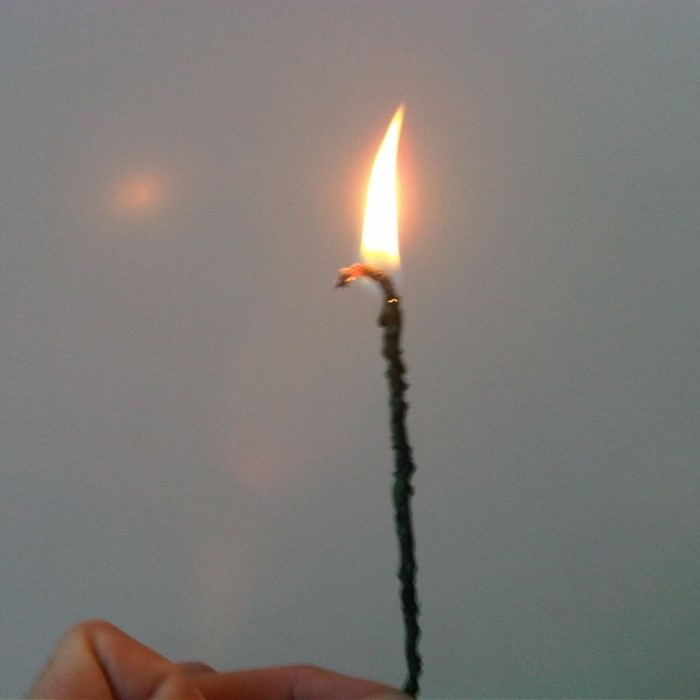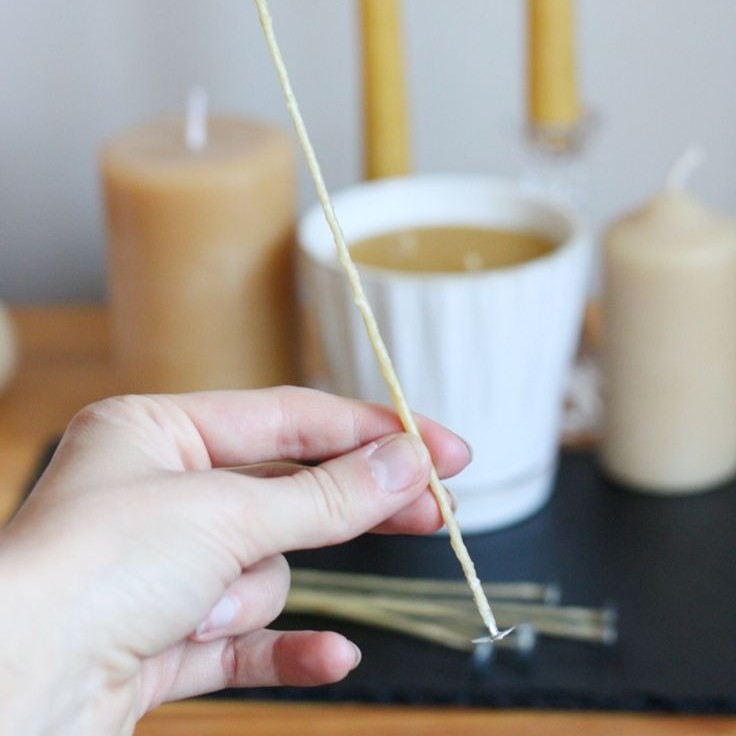Introduction
Candle-making is a wonderful hobby that allows for creativity and relaxation. However, a common question arises for many new crafters: “What can I use as a candle wick?” Understanding the role of a wick is essential, as it fuels the candle by drawing up melted wax and allowing it to burn properly. However, when traditional wicks are unavailable, alternatives can come to your rescue. In this article, we will explore various materials that can serve as effective candle wicks, offering safe and creative solutions for your candle-making projects.

The necessity of finding substitute materials for candle wicks becomes especially important in DIY projects. Whether you’re in a pinch or just like experimenting with different materials, knowing what you can use is invaluable. So let’s dive into some innovative wick solutions that will enhance your candle-making experience.
Understanding Candle Wicks and Their Function
What can i use as a candle wick? Before we explore alternatives, it’s crucial to understand what candle wicks do. The wick is the central component of a candle. It transfers melted wax to the flame, burning continuously to sustain the candle’s light. Here’s how it works:
- Wick Materials: Traditional candle wicks are typically made of braided cotton or wood. They are designed to absorb the wax and provide a controlled burn.
- Wick Functionality: As the candle burns, heat from the flame melts the wax near the wick. The molten wax is then drawn up through the wick via capillary action. This process keeps the flame alive and ensures a steady burn.
- Burn Rate and Size: The size and type of wick affect how quickly the candle burns. A thicker wick may produce a larger flame, while a thinner wick offers a more subtle burn. Choosing the right size is essential for achieving the desired ambiance and fragrance throw.
Understanding how traditional wicks function allows you to replicate their effects using alternative materials.
Creative Alternatives for Candle Wicks
Cotton String
- Household Item: Cotton string is a common item found in many homes. It’s often used for various tasks, such as crafting, gardening, or cooking.
- Suitable Substitute: Because of its natural material, cotton string serves as an effective substitute for traditional candle wicks. It burns well and draws wax effectively.
- Ensure 100% Cotton: When selecting cotton string, make sure it is 100% cotton. Avoid any synthetic fibers, as these can produce harmful fumes when burned and may not perform as well.
- Increasing Thickness: To improve performance, consider braiding multiple strands of cotton string. This technique increases the thickness of the wick, enhancing its ability to hold wax and burn steadily.
- Burning Capability: A thicker wick allows for more efficient wax absorption, leading to a longer-lasting candle with a consistent flame. Braiding strengthens the structure and aids in better burning.
Wooden Skewers
- Sturdy Alternative: Wooden skewers provide a robust option for larger candles. They are often used in cooking, making them an accessible choice for candle wicks.
- Creating a Wick: To make a wick with a wooden skewer, simply attach a small piece of cotton or fabric at one end. This attachment can be done using hot glue or by tightly wrapping it to secure it in place.
- Unique Aesthetic: Using wooden skewers not only serves a functional purpose but also adds a unique visual element to your candles. The natural wood offers an attractive appearance when the candle burns.
- Size Consideration: Be mindful of the skewer length when making candles. Longer skewers can be trimmed down to match the height of the candle container for the best fit and functionality.
- Maintain Stability: Ensure that the skewer remains upright in the melted wax while it solidifies. This stability is crucial for an even burn once the candle is lit.
Toothpicks
- Ideal for Small Candles: Toothpicks make for an excellent improvised wick, especially for smaller candles or tealights. They are readily available and simple to use.
- Preparation Method: To create a wick, dip the toothpick in melted wax. This coating helps to strengthen the toothpick and prepares it for burning.
- Hardening the Wax: Allow the wax-covered toothpick to harden before using it in a candle. This hardening process enhances the wick’s durability and burn quality.
- Minimalist Option: This method offers a minimalist approach to candle-making. Toothpicks do not take up much space and can be added easily to your candle design.
- Cost-Effective Solution: Utilizing toothpicks as wicks keeps your candle-making budget-friendly while promoting recycling and creativity in your projects.
Strips of Fabric
- Recycle Old Fabrics: Cut strips from old cotton fabric, like t-shirts or towels, to make homemade wicks. This recycling method promotes sustainability in your crafting efforts.
- Crafting the Wick: Once you have your fabric strips cut to length, consider braiding or twisting them together. This technique provides added strength and improves burning performance.
- Adaptable Size: Strips can be adjusted to different lengths based on your candle size. Ensure that your strips are long enough to reach the wax while leaving some above the surface for easy lighting.
- Diverse Textures: Using different fabrics allows for a variety of textures and styling in your candles. Customize the fabric choice to match the aesthetic of your created candles.
- Natural Burn: Since the fabric is natural, it burns cleanly without producing harmful substances. This aspect enhances the overall safety and enjoyment of your candles.
Paper Straws
- Unique Wick Option: If you have paper straws available, they can effectively serve as candle wicks. This approach is creative and adds a different design element to your candles.
- Modifying the Straw: Fill the paper straw with melted candle wax, ensuring it is packed tightly to maintain stability while burning. This filling contributes to the wick’s overall burn characteristics.
- Inserting Thread: Insert a piece of cotton thread into the middle of the filled straw. The thread will serve as the functional wick, drawing the wax upwards when lit.
- Lightweight Solution: Paper straws offer a lightweight alternative compared to traditional wicks. This characteristic is helpful for smaller candles where weight might affect stability.
- Eco-Friendly Choice: Using paper straws to create wicks falls in line with eco-friendly practices. They are biodegradable, contributing positively to waste reduction efforts.
By utilizing these alternative materials, you can successfully create functional and aesthetically pleasing candles while enhancing your DIY experience. Each option provides unique attributes, showcasing your creativity in candle making.
How to Make a Homemade Candle Wick
Creating a homemade wick is a straightforward process. Here’s a step-by-step guide to making your own candle wicks using easily accessible materials:
- Gather Your Materials: You will need cotton string or fabric, scissors, and a wax pot for dipping. Optionally, you can use a needle if you want to thread the wick through a skewer.
- Cut to Size: Cut the cotton string or fabric into your desired wick length. It should be slightly longer than the height of your candle.
- Soak in Wax: Melt some candle wax using a double boiler or microwave. Once the wax is melted, dip the cotton string or fabric into the wax, ensuring it is evenly coated. This step helps the wick burn more effectively.
- Shape and Dry: After soaking, remove the wick and allow it to cool and harden. If using a skewer, insert the wick into the skewer before the wax hardens to ensure it stays in place.
- Use in Your Candle: Once everything is dry, your homemade wick is ready to be used in any new candle-making project!
By following these steps, you can create versatile and functional wicks tailor-made for your candle-making needs.
Common Household Items That Can Be Used as Wicks
What can i use as a candle wick? Apart from dedicated candle wick materials, you might have several household items suitable for use as candle wicks. Here are some of the best options to consider:
- Old Cotton T-shirts: Cut strips from any old cotton T-shirt. These can easily be braided or twisted to create a wick that functions well in homemade candles.
- Mop Heads: If you have an unused mop head made from cotton, its strands can be utilized as a wick. Just cut off a suitable length and dip it in wax.
- Uncooked Pasta: Some people have successfully used uncooked spaghetti as a makeshift wick. While not ideal for prolonged use, it can work in a pinch.
- Yarn or Twine: If your yarn is made from 100% cotton or natural fibers, it can function as a wick. Just ensure to braid or twist it for better burning capability.
- Bamboo Sticks: Thin bamboo skewers can be transformed into wicks by wrapping a piece of cotton fabric around the top end. They provide stability and a unique look.
Exploring these household options encourages creativity and allows for resourcefulness when crafting candles.
Natural Wicks for Candles
Many candle enthusiasts seek to use natural materials for wicks. These materials not only align with eco-friendly practices but also provide an enjoyable burning experience. Here are a few natural wick options:
- Beeswax Wicks: Made from the wax produced by bees, these wicks burn cleanly and are sometimes used in high-quality candles. They can be paired with cotton or natural fiber bases to enhance their structural integrity.
- Bamboo Wicks: Bamboo is becoming a popular natural alternative for candle wicks. They create a unique burning experience and often produce a lovely crackling sound reminiscent of a fireplace.
- Hemp Twine: Hemp is biodegradable and burns well. By tightly braiding hemp twine, you can create your own eco-friendly candle wicks.
- Jute Rope: Natural jute rope can also serve as an alternative wick. It usually provides a rustic look and burns effectively when infused with wax.
- Cotton Wicks with Natural Dyes: For those who wish to add color to their candles, consider using cotton wicks dyed with natural sources. This approach enhances aesthetics while keeping it eco-friendly.
Using natural materials encourages sustainability and reduces reliance on synthetic options.
Frequently Asked Questions (FAQs)
- What can you use instead of a candle wick?
You can use materials like cotton string, wooden skewers, and fabric strips as substitutes for candle wicks, as well as household items like old T-shirts and mop heads. - How do you make a homemade candle wick?
To make a homemade wick, cut a piece of cotton string, dip it in melted wax, allow it to cool, and then use it in your candle-making project. - What household items can be used as a wick?
Household items like cotton yarn, bamboo skewers, and even uncooked pasta can serve as candle wicks in DIY projects. - What is a natural wick for candles?
A natural wick can be made from materials like beeswax, hemp twine, or bamboo. These options are environmentally friendly and provide a clean-burning experience.
Conclusion: Innovative Approaches to Candle Wicks
In summary, the question “What can I use as a candle wick?” has many creative answers. From using traditional candle wicks to repurposing household items, there is an impressive variety of materials at your disposal. By exploring alternatives and understanding how to create homemade wicks, you can further enjoy your candle-making experience, reduce waste, and foster creativity.
Taking the time to experiment and find suitable substitutes not only makes your projects more interesting but also reinforces the importance of sustainability in crafting. So, the next time you’re planning a candle-making adventure, don’t hesitate to think outside the box and explore the numerous wick solutions available to you!







